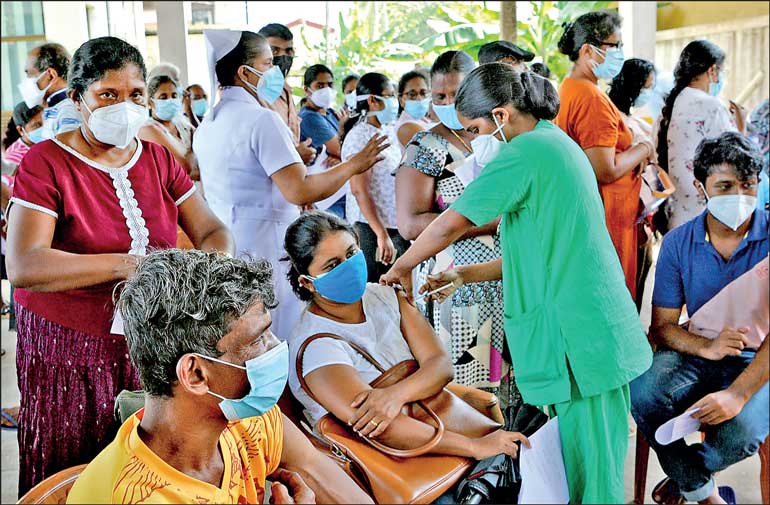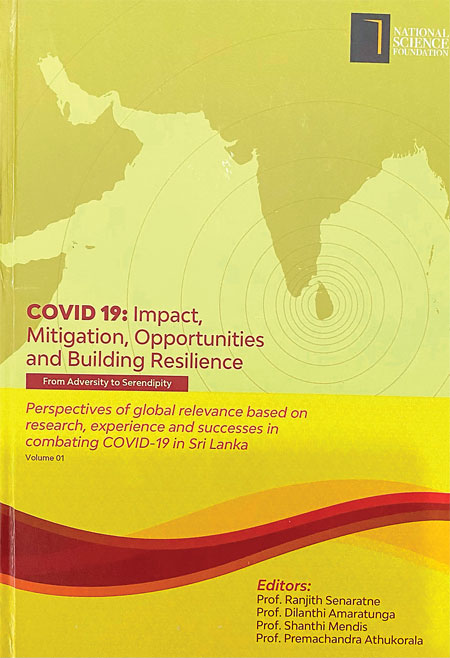Sunday Feb 23, 2025
Sunday Feb 23, 2025
Monday, 10 January 2022 00:00 - - {{hitsCtrl.values.hits}}

Pic by Shehan Gunasekara
|
 NSF to rescue
NSF to rescue
The National Science Foundation, abbreviated as NSF, in a voluminous publication issued in late 2021, has documented the impact of the outbreak of the COVID-19 pandemic on Sri Lanka and the lessons learned from action taken to counter it. The publication titled ‘COVID-19: Impact, Mitigation, Opportunities, and Building Resilience’ has been edited by four eminent academics, namely, Ranjith Senaratne, Dilanthi Amartunga, Shanthi Mendis, and Prema-chandra Athukorala.
Under this main editorial board, there have been sub-editors and section chairs who also have done yeoman service to bring the volume to a reality. The papers published in the present volume had been drawn from presentations made by hundreds of academics of Sri Lankan origin at a national conference hosted by NSF earlier in the year. It has been an enviable task which the four editors have accomplished by improving and editing the original papers making them publication-worthy in a peer-reviewed volume of 790 pages of small print.
Key areas of analysis
The papers in the volume have been listed under 10 key sections. The first section includes six keynote addresses and plenary papers presented at the conference. The other papers cover health, mental health and wellbeing, economy, environment, society and education, building resilience, governance, supply chain, and research and inventions. Each of these sections is preceded by an introduction summarising the key points made in the research papers following them. It sets the stage for readers to understand what is to be expected of the papers that have been listed under that section.
Review of some selected papers
Because of the space limitations, it is not possible to review all the 66 papers that have been included in this volume. Hence, the focus will be on some selected papers, especially, those relating to the economy and future research and inventions. It by no means suggests that other papers are unimportant and should not receive the attention of the readers. To the contrary, they are all worthy of the attention of the prospective readers.
Science behind the pandemic
Malik Peiris, in his keynote address, has set out the science behind the coronavirus disease of 2019, dubbed as COVID-19, and opined that an inclusive vaccination program will be the way out for the globe to tackle this highly contagious respiratory disease. However, he has warned that vaccination alone is not sufficient to eradicate the pandemic that has been spreading fast across all the countries in the world. Hence, the world will have to live with the disease for many more years to come. What is preventing the world authorities from successful eradication is the emergence of new variants of the virus that partially evade the immunity which the vaccine may have delivered to the vaccinated people.
He has recommended to the authorities that a global surveillance system should be established to identify such new variants and tackle them at source. He had expressed this wisdom in January 2021. Since then, the world has witnessed the emergence of several new variants which have been more contagious and lethal compared to the previous ones. The story has not ended there with the discovery of the most recent variant, tagged Omicron, which is now replacing the older one tagged Delta.
What Peiris has suggested is that there will be a never-ending war between coronavirus variants and new vaccines to tackle them. It means that the authorities cannot be complacent about the success already achieved but be watchful of the possible unexpected disruptions that might hit the world. This is a good lesson for both health authorities and economic policymakers.
 Poverty of the global south
Poverty of the global south
Poor countries, usually classified as the global south, are poor not only in knowledge but also in deciding on priorities and planning for facing catastrophes. This has been the theme of the keynote address delivered by Mahesh Nirmalan et al under the title ‘COVID-19: Have we got our priorities right planning for the pandemic in low resource setting in the global south’. But this is not typical to poor countries as reports from Australia now reveal. With the recent outbreak of the pandemic with the Omicron variant, Australia’s established healthcare system including the ability to conduct testing has been overstretched.
Nirmalan et al have pointed out that the intensive care units with ventilators and oxygen delivery facilities in poor countries have been far from adequate. Sri Lanka too faced this problem when the fourth wave of the COVID-19 pandemic with Delta variant hit the country in May 2021.
The suggestion by Nirmalan et al has been that instead of going for a few sophisticated ICUs with advanced ventilators and oxygen delivery systems, the resource poor global south should establish field facilities to care for as many patients as possible simultaneously. It appears that Sri Lanka’s military took this advice seriously when they set up several such field hospitals to make the treatment inclusive rather than exclusive.
Importance of the community-based approach
Handling a pandemic of this nature cannot be accomplished by the government alone. The community-based organisations and community leaders should also play an important role in supplementing the work of the government. Vinya S. Ariyaratne in his plenary paper titled ‘The importance of community engagement in combating COVID-19’ has argued that Sri Lanka was able to combat effectively the first wave of the pandemic in March 2020 through active people’s participation to supplement the government action. But this was not the case with the second wave of the pandemic that hit the country in October 2020. Hence, Ariyaratne has suggested that community engagement should be promoted with removing the stigma and discrimination that are being attached to the patients of the pandemic.
Indigenous medicines can also be used
G.A.S. Premakumara in his plenary paper titled ‘Phytochemical and pharmacological aspects of indigenous medicine’ has presented the case for the use of such medicine to combat this type of pandemics. This is a controversial subject because when indigenous medicine is used for this purpose, one should make a clear distinction between real science and pseudo-science. In this connection, Premakulara’s paper is based on real science.
This is important for Sri Lanka because with the outbreak of the pandemic and people becoming destitute, many pseudo-indigenous medical practitioners emerged as the saviours of the people. With the patronage of some government leaders, they introduced to people various decoctions of doubtful efficacy and mythological cult practices. The paper by Premakumara should be an eye-opener for policy leaders because he has very clearly outlined how science should be applied when using indigenous medicine for this purpose.
The global and local economic downturn
The global economy has been the largest victim of COVID-19 pandemic. According to data available, the global economy contracted by 3.4% in 2020, compared to an expansion of 2.9% in 2019. The output loss in 2020 is about $ 4 trillion. In 2021, the present forecast shows that the global economy will have a growth of 5.7%, based on the low base in 2021. In 2022, growth is projected to be at 4.5%. Sri Lanka too had a frustrating experience with respect to economic performance. In 2020, growth became negative at 3.6%, down from the growth of 2.3% in the previous year. In 2021, the growth is projected to be around 2% and will have a slight improvement in the next few years. The country will return to its long-term economic growth path only by 2025. In this context, the section on the economy containing six papers is of utmost importance.
A prolonged U-shaped recovery
W.A. Wijewardena in his paper titled ‘Covid-19 pandemic and the suggested economic recovery plan’ has argued that it will not be a V-shaped quick recovery but a U-shaped prolonged recovery which Sri Lanka will have in the post-COVID era. Hence, he has suggested that Sri Lanka should switch over to a high-tech product mix from the current low-tech product mix. It will enable Sri Lanka to leapfrog from the present Second Industrial Revolution to Fourth Industrial Revolution by-passing the Third Industrial Revolution.
The five-pillar strategy to be adopted by Sri Lanka to attain this goal has been joining the global production sharing networks, acquiring market access, attracting foreign direct investments that accompany high technology, increasing Sri Lanka’s research and development expenses, and overhauling the education system with emphasis on science, mathematics, engineering, creative art, and technology.
|
Ground conditions for macroeconomic recovery
The paper titled ‘Adjusting to COVID-19: Sri Lanka’s macroeconomic policy levers and impacts’ by Dushni Weerakoon has warned the country’s policymakers that there is a limit to using lax fiscal stimulants and loose monetary policy interventions to combat a pandemic like this. A country will be specifically vulnerable if it has a high public debt level at the beginning. Sri Lanka is such a country with its public debt at 90% of GDP in early 2021 but more than 115% as at today. If Sri Lanka is to attain a V-shaped quick recovery as envisaged by policymakers, it should necessarily remedy its macroeconomic imbalances.
The resilience and sustainability of the recovery process, she argues, will depend on reforming the fiscal sector and ensuring debt sustainability appropriately. If this is not done, she says that there will be fragile recovery making the country vulnerable to similar catastrophes in the future. This is a bitter pill which Weerakoon has suggested. Since her paper in early 2021, the country’s fiscal and monetary situ has further deteriorated and now reached a level beyond redemption.
Growth in a historical perspective
Prema-chandra Athukorala has dissected the policy debate in Sri Lanka as to whether it should go for an import substitution policy or export promotion policy to regain the lost opportunities and come out of the present economic malaise. The paper titled ‘Rethinking Sri Lanka’s industrialisation strategy: Achievements, lost opportunities, and prospects’ has taken the reader through the changes in the policy stance in favour of import substitution based on ideology rather than hard-hitting evidence. The country has failed to reap the full benefits of economic reforms because they have been either partially implemented or abandoned mid-way through.
If import substitution is to be implemented, Athukorala says that it should be combined with export orientation with focus on specific sectors. Instead, if selective policies are adopted to promote import substitution, it will be a tax on exports. It is specifically relevant to Sri Lanka in the current context because there is a growing tendency to go for import substitution without paying due attention to export promotion. Without exports, Sri Lanka will not be able to resolve its chronic as well as acute external sector crisis. Hence, Athukorala’s recommendation is opportune and timely.
Governance issues should not be ignored
When a country is down with a catastrophe, a casualty within the political system is governance which tends to be ignored by political authorities. When it becomes necessary to deliver relief to affected people quickly on one side and prevent the spread of the pandemic on the other, authorities cannot observe agreed best practices of governance. Yet, it does not mean that a country should ignore it altogether. Two papers under the governance section have sought to present two case studies in which governance principles were followed without disruption during the COVID-19 pandemic in Sri Lanka.
Case studies on governance relating to IRD and PIM
The first paper by A.C. Uwais and S. Rathnayake refers to the tax administration and governance in transfer pricing in post-COVID-19 transition. The second paper by A.S. Dharmasiri has highlighted how the Postgraduate Institute of Management, known in its abbreviated form as PIM, adjusted its ways to deliver its services to stakeholders under the conditions of a planetary pandemic. The Uwais and Rathnayake paper has argued that multinational enterprises should have a transfer pricing policy governance code based on value-chain reorganisation and proper documentation reckoning key economic and risk factors.
They opine that instead of litigation, alternative dispute resolution systems should be followed by tax authorities. This is in line with the ancient Indian principle of taxation in which tax authorities should collect taxes like the bee which sucks nectar from a flower without trampling on it. Dharmasiri has presented in his paper how the PIM responded to the challenge of delivering education and training without compromising its bedrock of values, vision, and mission involving all the stakeholders. Its goal of attaining excellence hovers over PIM like a giant edifice. Dharmasiri has presented how that goal was realised without breaking that edifice into pieces.
Inventions to be converted to innovations
The paper by Nadeeja Wickramarachchi et al has documented Sri Lanka’s experience of transforming inventions to impactful innovation during the pandemic. The distinction between invention and innovation has been first identified by the Austrian American economist Joseph Schumpeter in his 1942 book on Capitalism, Socialism, and Democracy. Inventions made by scientists and engineers become purposeless unless they are commercially produced by businessmen who are called innovators. The presence of both is therefore necessary for a society to thrive and prosper.
In this context, Wickramarachchi et al have opined that during the pandemic, a platform was devised to come up with local economy-based inventions in Sri Lanka. This was done in the areas of public health, economy, and society during the first wave of the pandemic. However, it began to lose its steam during the second wave which is a concern. This has been due to the presence of many barriers relating to transforming inventions to innovations. Therefore, the authors have recommended that those barriers should be removed to enable Sri Lanka’s economy to sustain its growth potential.
A final word
The review relates only to some selected papers in the publication by NSF. The book, if converted to a program of action, will serve well for Sri Lanka’s policymakers to ensure a quick recovery of the systems disrupted by the outbreak of the COVID-19 pandemic in several waves.
(The writer, a former Deputy Governor of the Central Bank of Sri Lanka, can be reached at [email protected].)
Discover Kapruka, the leading online shopping platform in Sri Lanka, where you can conveniently send Gifts and Flowers to your loved ones for any event including Valentine ’s Day. Explore a wide range of popular Shopping Categories on Kapruka, including Toys, Groceries, Electronics, Birthday Cakes, Fruits, Chocolates, Flower Bouquets, Clothing, Watches, Lingerie, Gift Sets and Jewellery. Also if you’re interested in selling with Kapruka, Partner Central by Kapruka is the best solution to start with. Moreover, through Kapruka Global Shop, you can also enjoy the convenience of purchasing products from renowned platforms like Amazon and eBay and have them delivered to Sri Lanka.
Discover Kapruka, the leading online shopping platform in Sri Lanka, where you can conveniently send Gifts and Flowers to your loved ones for any event including Valentine ’s Day. Explore a wide range of popular Shopping Categories on Kapruka, including Toys, Groceries, Electronics, Birthday Cakes, Fruits, Chocolates, Flower Bouquets, Clothing, Watches, Lingerie, Gift Sets and Jewellery. Also if you’re interested in selling with Kapruka, Partner Central by Kapruka is the best solution to start with. Moreover, through Kapruka Global Shop, you can also enjoy the convenience of purchasing products from renowned platforms like Amazon and eBay and have them delivered to Sri Lanka.